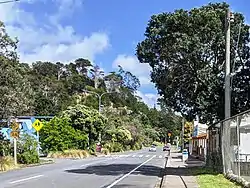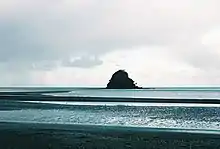Waiwera
Waiwera is a small town in the north of the Auckland Region in New Zealand.[3] Waiwera is 6 km north of Orewa, 6 km south-east of Puhoi, 23 km south-east of Warkworth and approximately 35 km from the Auckland City centre. The settlement lies at the outlet of a river also called Waiwera. Less than 1 kilometre north of the Waiwera turn-off lies the turn-off to Wenderholm Regional Park which is situated on the far side of the headland to the north of the Waiwera River outlet.
Waiwera | |
|---|---|
 Waiwera Road | |
| Coordinates: 36°32′41″S 174°42′25″E | |
| Country | New Zealand |
| Region | Auckland Region |
| Ward | Albany ward |
| Local Board | Hibiscus and Bays Local Board |
| Electorates | |
| Government | |
| • Territorial Authority | Auckland Council |
| Area | |
| • Total | 0.55 km2 (0.21 sq mi) |
| Population (June 2023)[2] | |
| • Total | 230 |
| • Density | 420/km2 (1,100/sq mi) |
History
The name is of Māori origin and means "Hot Water" (Wai = Water and Wera = Hot),[4] and is a shortened version of the traditional name Waiwerawera.[5]
Its main claim to fame was the hot water springs which were well known in pre-European times and reputedly visited by Māori from as far away as Thames. The first European settler to promote the springs was Robert Graham who established a health resort in 1848. During the late 19th century there was a regular steam ferry service from Auckland.[6] The commercial hot pools closed in 2018.[7]
Demographics
Statistics New Zealand describes Waiwera as a rural settlement, which covers 0.55 km2 (0.21 sq mi)[1] and had an estimated population of 230 as of June 2023,[2] with a population density of 418 people per km2. Waiwera is part of the larger Wainui-Waiwera statistical area.[8]
| Year | Pop. | ±% p.a. |
|---|---|---|
| 2006 | 192 | — |
| 2013 | 237 | +3.05% |
| 2018 | 240 | +0.25% |
| Source: [9] | ||

Waiwera had a population of 240 at the 2018 New Zealand census, an increase of 3 people (1.3%) since the 2013 census, and an increase of 48 people (25.0%) since the 2006 census. There were 150 households, comprising 123 males and 120 females, giving a sex ratio of 1.02 males per female. The median age was 54.8 years (compared with 37.4 years nationally), with 21 people (8.8%) aged under 15 years, 21 (8.8%) aged 15 to 29, 126 (52.5%) aged 30 to 64, and 72 (30.0%) aged 65 or older.
Ethnicities were 86.2% European/Pākehā, 8.8% Māori, 1.2% Pacific peoples, 6.2% Asian, and 3.8% other ethnicities. People may identify with more than one ethnicity.
Although some people chose not to answer the census's question about religious affiliation, 42.5% had no religion, 35.0% were Christian, 1.2% had Māori religious beliefs, 1.2% were Hindu, 2.5% were Muslim, 1.2% were Buddhist and 6.2% had other religions.
Of those at least 15 years old, 48 (21.9%) people had a bachelor's or higher degree, and 27 (12.3%) people had no formal qualifications. The median income was $30,100, compared with $31,800 nationally. 33 people (15.1%) earned over $70,000 compared to 17.2% nationally. The employment status of those at least 15 was that 90 (41.1%) people were employed full-time, 30 (13.7%) were part-time, and 9 (4.1%) were unemployed.[9]
References
- "ArcGIS Web Application". statsnz.maps.arcgis.com. Retrieved 27 May 2022.
- "Subnational population estimates (RC, SA2), by age and sex, at 30 June 1996-2023 (2023 boundaries)". Statistics New Zealand. Retrieved 25 October 2023. (regional councils); "Subnational population estimates (TA, SA2), by age and sex, at 30 June 1996-2023 (2023 boundaries)". Statistics New Zealand. Retrieved 25 October 2023. (territorial authorities); "Subnational population estimates (urban rural), by age and sex, at 30 June 1996-2023 (2023 boundaries)". Statistics New Zealand. Retrieved 25 October 2023. (urban areas)
- "NZGB Gazetteer | linz.govt.nz". gazetteer.linz.govt.nz. Retrieved 18 April 2021.
- "Waiwera Travel Guide". Jasons Travel Media.
- Cameron, Ewen; Hayward, Bruce; Murdoch, Graeme (2008). A Field Guide to Auckland: Exploring the Region's Natural and Historical Heritage. Random House New Zealand. p. 122. ISBN 978-1-86962-1513.
- Wises New Zealand Guide. 1979. p. 490.
- Williams, Caroline (24 May 2021). "Million-dollar dumps: Waiwera's abandoned hot pools a 'taonga being wasted'". Stuff. Retrieved 27 May 2022.
- 2018 Census place summary: Wainui-Waiwera
- "Statistical area 1 dataset for 2018 Census". Statistics New Zealand. March 2020. 7001364.